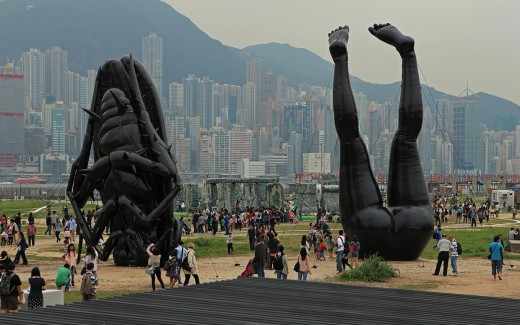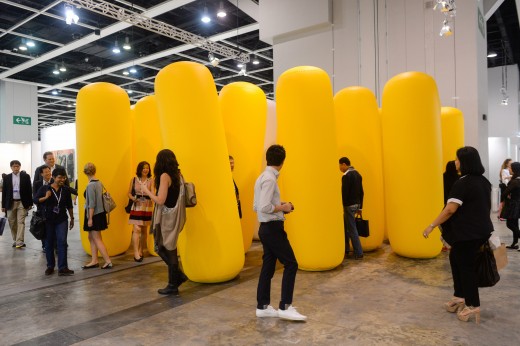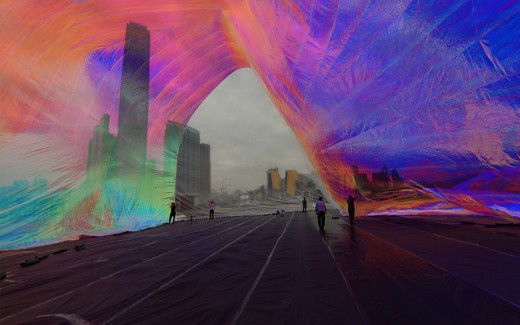
Marc Quinn’s Stealth Desire (Etymology) at White Cube. Photo: Vincent Tsang, Image courtesy of White Cube
Hong Kong is a city of clashing identities. Influenced by Eastern traditions and Western colonialism, by age-old practices and modern impulses, Hong Kong’s quotidian mise-en-scène often consists of paradoxical images: Prada-clad women waiting in line for a $3 bowl of noodles, double-decker trams—an affordable public transportation system since 1904—pushing through traffic alongside Maseratis, glistening skyscrapers that mingle with ancient Chinese temples, repurposed 1910-20s neoclassical post offices and police stations, and stacked post-war Bauhaus-style shop houses. A leading international financial center and major tourist destination with a diverse and vibrant cultural identity, Hong Kong is now the home of Art Basel’s presence in the Asia-Pacific region, numerous Western commercial gallery outposts, and the forthcoming M+ Museum—whose building is designed by Herzog & de Meuron. It is a story we in Miami know all too well.
In 2008, when Hong Kong International Art Fair (also known as Art HK) was first established, the city’s art scene and market was often discounted and merely regarded as a gateway to Beijing and Shanghai, which at the time were experiencing the Chinese contemporary art boom. Daniel Ho, Editor in Chief of Randian, a contemporary art website specializing in Chinese art, comments “Hong Kong has its own scene, [which is] historically quite separate from the Mainland Chinese scene, and is also a kind of feeder [or] market for the Mainland art scene, to a limited degree.” When Adrian Wong—a Hong Kong-based artist who was commissioned by Absolut Art Bureau to create an installation art bar for last year’s Art Basel Hong Kong—first moved from Chicago in 2005, Hong Kong did not have much of an international caliber and the scene was rather naïve. He credits Art HK for starting the ball moving, simultaneously changing what young and emerging local artists had access to and developing a platform for these artists to gain prominence internationally.
Today, it has risen to the status of an art powerhouse, taking over the coveted position as the heart and hub of contemporary art and art trade of Asia. The geographical epicenter of Asia, located in the South China Sea at the mouth of Pearl River Delta, Hong Kong’s close proximity and accessibility to major Asian capitals and financial hubs—Taipei, Singapore, Tokyo, and Shanghai—makes the city a likely contender for art-market development. The English-speaking city, with its shared history with the West, feels both user-friendly and approachable. Moreover, the absence of any import, export, or sales tax is an added motivator behind Hong Kong as the regional base for Sotheby’s and Christie’s auction houses and expansions for blue-chip galleries, such as White Cube, Gagosian, Simon Lee, and Lehmann Maupin.
In 2011, MCH Group—owner of Art Basel and Art Basel Miami Beach—announced it acquired a majority 60 percent stake in Art HK, and in May last year, Art Basel Hong Kong opened to the public. The fair, located at Hong Kong Convention Center in Wan Chai district on the Victoria Harbor, has retained its core values of promoting geographic diversity with at least 50 percent of the galleries coming from the Asia-Pacific region. The successes of Art Basel Hong Kong and its earlier iterations as Art HK have attracted an influx of new collectors, galleries, and art professionals to the scene. Gallery participation in the fair since its foundation in 2008 has steadily grown, with a showcase of 100 galleries in 2008 to 245 galleries in 2013. The fair’s rebranding into the globally recognizable trademark simultaneously addressed the existing and growing pool of collectors in the region, while expanding opportunities for outside cultural producers to achieve both profitability and prominence.
The majority of Western blue-chip gallery outposts are concentrated in the Queens Road Central, a mecca for luxury fashion brands, high-end retail boutiques, and legendary five-star hotels such as the iconic Mandarin Oriental. Located on this frenzied shopping strip, the Pedder Building—a neoclassical stone building built in the 1920s and a standing symbol of Hong Kong’s colonial history—nests a majority of these galleries with London’s Simon Lee Gallery, Ben Brown Fine Arts, Lehmann Maupin, China’s Pearl Lam, and Gagosian. With a shortage of ample commercial spaces, the Pedder galleries are crammed amongst each other and fighting for space with other bespoke boutiques and labels. The ground floor of the Pedder Building is home to the city’s first and only Abercrombie & Fitch store. Upon entering, one is simultaneously greeted with a four-story billboard of two bronzed and barely-clothed Abercrombie models and hit with a wave of the brand’s signature cologne. With that, western capitalism and parvenu consumerism could not be more apparent.
Half a mile away, White Cube and Galerie Perrotin share a newly built skyscraper with Agricultural Bank of China. This January at White Cube, a larger-than-life black sculpture of an orchid head by YBA Marc Quinn, occupied the gallery on the first floor. One cannot resist drawing symbolic associations between the sculpture and the Hong Kong Orchid Tree, discovered in the city and embodied in the city’s flag. Quinn’s first solo exhibition in Hong Kong includes more sculptures inspired by Chinese works from a visit to the Taipei Palace Museum. Reflective of a Chinese influence include Quinn’s Chinese juniper tree in lacquered bronze, and two works—an oversized sculpture of a Spanish Serrano ham in pink onyx and jade sculpture of a human iris engraved with the map of the world and formed of an ancient Chinese jade disc. With a painfully blatant corporate identity and artworks distinctly specialized, the city’s collector base of freshly minted millionaires and billionaires could not feel more at home.
Possibly the most significant and promising development in Hong Kong’s art scene is the formation and construction of West Kowloon Cultural District (WKCD). Spanning 40 hectares of reclaimed land on the Victoria Harbor waterfront, the new development will encompass a museum of visual culture (M+ Museum), an outdoor art pavilion, and 15 performing arts venues. The museum, designed by Herzog & de Meuron, is slated to open in 2017. Under the direction of Executive Director Lars Nittve—the founding Director of Tate Modern and former Director of Moderna Museet in Stockholm— M+ Museum aspires to be a global platform for visual culture, which includes 20th- and 21st-century art, architecture and design, and moving image. The institution aims to address what Nittve terms as “dynamic glocalism,” a comprehensive collecting and programming strategic model focused on Hong Kong, the Pearl River Delta, and China at its core while maintaining an expanded global vision. With the government-backed funding of up to $6 billion Hong Kong dollars (US$775 million), the museum has already acquired the legendary collection of Swiss collector Uli Sigg. Part gift, part purchase, this acquisition of 1,510 Chinese contemporary artworks by leading and pivotal artists such as Ai Weiwei, Zhang Xiaogang, and Fang Lijun falls in line with the museum’s commitment to ground their international collection in a local and regional context.

Tam Wai Ping’s Falling into the Mundane World at Mobile M+ exhibition Inflation! Image courtesy of West Kowloon Cultural District Authority.
Amidst the conspicuous commerciality, a quieter yet resilient sector of Hong Kong’s art macrocosm thrives on. Not-for-profit art organizations and alternative exhibition spaces such as Para/Site, Asia Art Archives, and Spring Workshop have been credited with generating ongoing discourse, organizing didactic exhibitions and programs, and promoting local and emerging artists.
Para/Site, founded in 1996, was one of the first artist-run alterative exhibition spaces, producing exhibitions, publications, curatorial, and artist residency programs devoted to showcasing local and regional contemporary histories through a critical and sociopolitical perspective. In the summer of 2013, Para/Site mounted its most internationally successful and critically celebrated exhibition yet. A Journal of the Plague Year. Fear, ghosts, rebels. SARS, Leslie, and the Hong Kong Story explored the implications of certain critical events in the past decade on the city’s complex sociopolitical, pop-cultural, and epidemiological history. The organization has been instrumental in drawing worldwide attention to Hong Kong artists such as Lee Kit and Frog King, both of who represented Hong Kong at the Venice Biennale 2013 and 2011, respectively. Similarly, newest kid on the block, Spring Workshop—which opened in industrial Wong Chuk Hang in August 2012— is committed to its program as an international host for cross-disciplinary artist and curatorial residencies, exhibitions, and lectures and film programs.
Over the years, Hong Kong has successfully attracted a number of international artists including Chicago’s Adrian Wong and Portugal-born Joao Vasco Paiva. Combined with the number of local artists such as Warren Leung Chi-Wo, Nadim Abbas, Kacey Wong, and recent Hugo Boss Asian Art Award winner Kwan Sheung Chi, Hong Kong is not lacking local and emerging artists. The artists, however, are often marginalized due to a lack of market for their work. For the most part, this has been attributed to the astronomically high cost of living and exorbitant rent prices.

One and J. Gallery at Art Basel Hong Kong 2013. Image courtesy of Art Basel/MCH Messe Schweiz (Basel) AG.
Artists and galleries are not exempt from these conditions, and have suffered setbacks of living in such an expensive city. Two local galleries, Gallery Exit and Osage Gallery, have relocated their spaces from the downtown, central areas of Hong Kong Island to more distant locations. With high overheads and low price points for emerging and local artists, it is not surprising that Gagosian would mount a Damien Hirst exhibition and that local galleries like Hanart would exhibit Chinese contemporary artist Fang Lijun, whose paintings sell for up to US$700,000 at Christie’s. Furthermore, despite an interested and engaged audience for contemporary art in Hong Kong, there is not yet a comprehensive and educated understanding of conceptual art, making the decision for galleries to mount experimental, progressive, and unfamiliar artists much more of a gamble.

“Poetic Cosmos of the Breath” by Tomas Saraceno at Mobile M+ exhibition Inflation! Image courtesy of West Kowloon Cultural District Authority.
Wong’s sentiments echo those of Cosmin Costinas, Executive Director of Para/Site, who in an interview with Time Out Hong Kong recognized the need to “hear more loudly the voice of [local] artists.” It is generally understood that building a robust art community requires a strong arts infrastructure with networks of support systems embedded within the city. To Rebecca Catching, art critic and Managing Editor of Randian, “a few Western galleries and an art fair does not an art scene make.” However, Wong is determined to remain optimistic. “I think it’s too early to start worrying about backlash. We’re just at the beginning, and obviously with any rapid expansion and growth, you have problems with the lack of infrastructure, but discursively, the city’s become a lot richer.”










